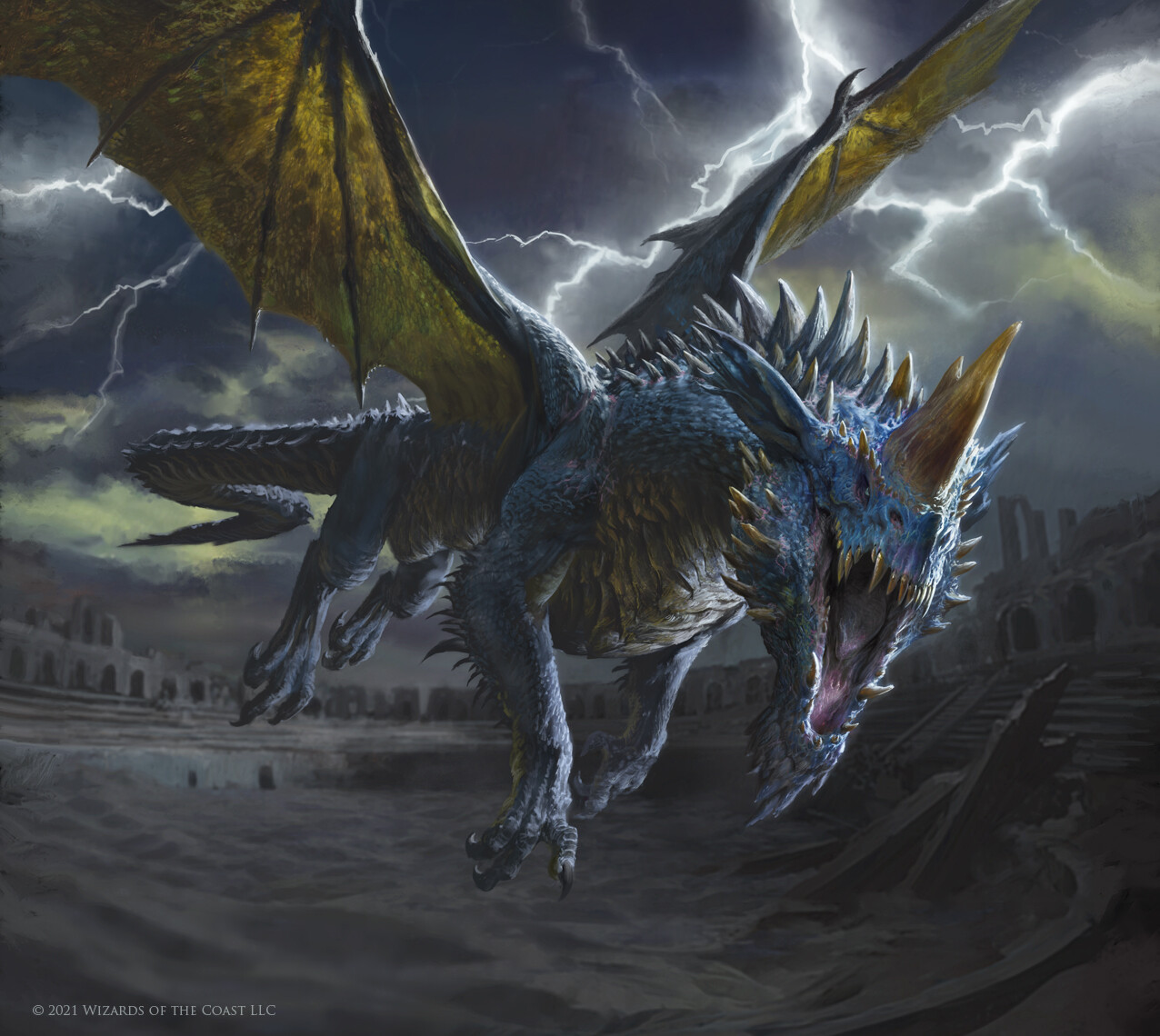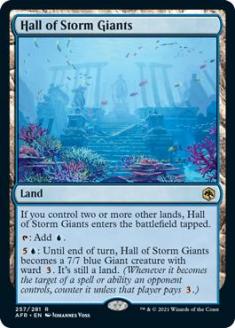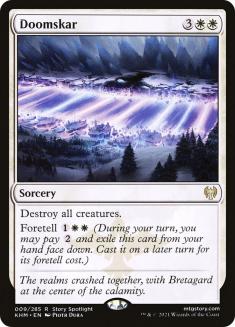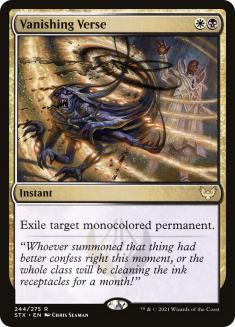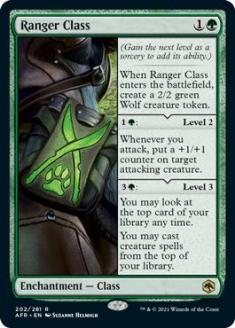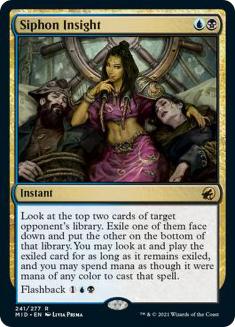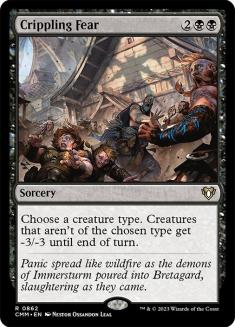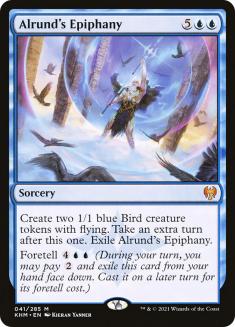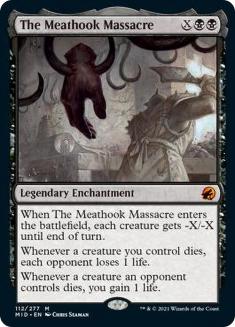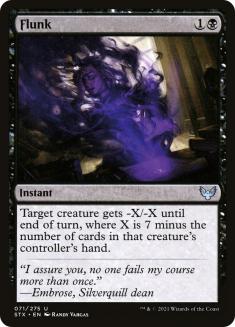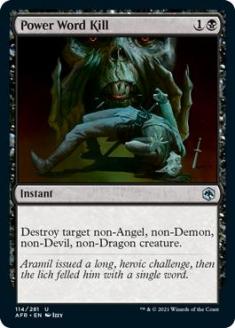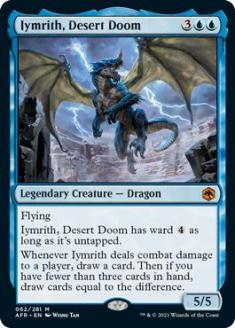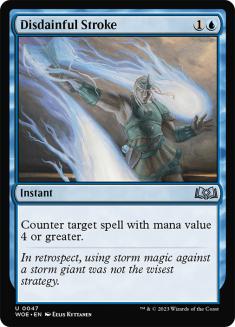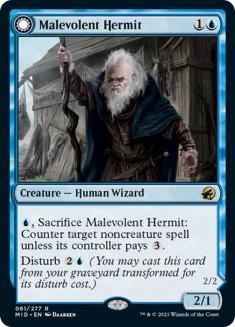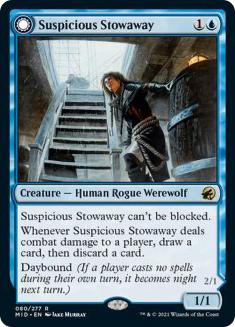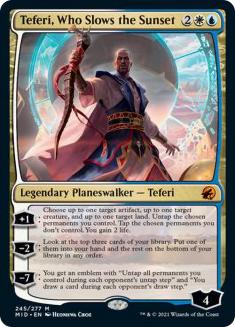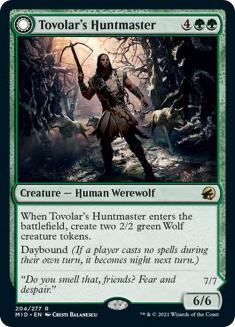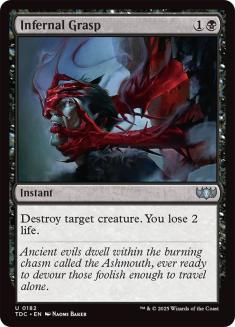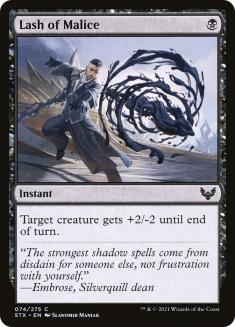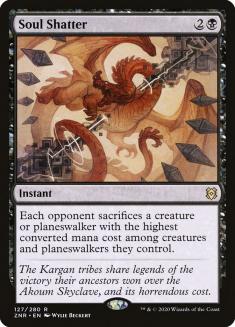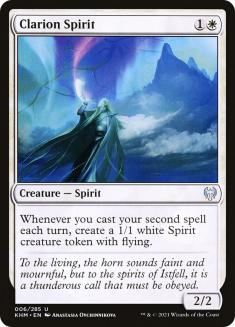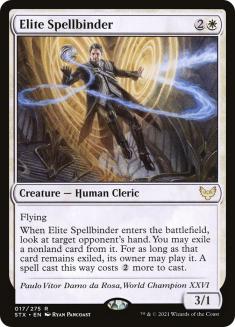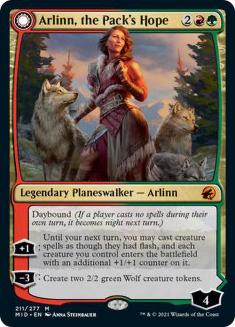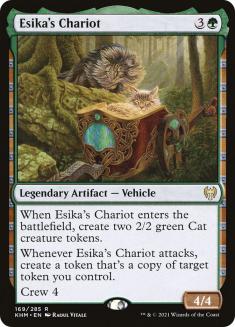Innistrad: Midnight Hunt Standard has been a huge hit across the spectrum of players. From competitive to casual folks, gameplay has returned to a respectable state. The egregious development errors of the past have left us, with only a few grumblings directed at cards already deemed too powerful. That is a natural reaction for players fully plugged into the game, expecting the system to be broken, as it’s been for a couplof e years. Luckily, most players see the format as successful, or at least give it a bit of a grace period before declaring it dead on arrival.
In this new, open format, I have landed on Dimir Control as my deck of choice. Esper Control is gaining on it; however, the mana can still be a little tricky for what I’m trying to accomplish. Due to the extra color, less creature-lands can be played and that’s unacceptable to me, especially with the strength of Hall of Storm Giants. That was an easy called shot for me, coming in at #3 in my Adventures in the Forgotten Realms First Impressions: Standard article. This creature-land can knock out an opponent in a couple of turns out of nowhere, especially with its attached ward protection. Outside of the drop in creature-lands, more lands enter the battlefield tapped in a format that’s turning out to be more aggressive than initially anticipated.
Dimir Control is only lackluster in the sweeper department, compared to Esper Control. If the format outgrows waves of early threats and becomes more midrange-based as I initially predicted, I will revisit my deck choice. For now, I’ve decided to go with the more a mana-consistent, streamlined control deck that rarely stumbles. This is the list I’m currently battling with:
Creatures (3)
Lands (25)
Spells (32)

I have been hesitant in the past with producing full sideboard guides, especially with a new format that requires adjustments on a regular basis. This can be confusing when entire swaths of disruption are swapped out for others and is often the case when new, popular matchups call for drastic measures. With this initial launch of Dimir Control in Standard, I wanted to produce this content to at least give basic guidance against the biggest decks of the format. Control has not been viable for quite some time; now that it is, a little direction from the truest believer may be beneficial to all those reading.
Matchup Analysis
VS Mono-Green Aggro❄
Creatures (18)
Lands (25)
Spells (17)

This is one of the matchups where I truly feel the pain of not having access to white. Doomskar and Vanishing Verse are both all-stars against Mono-Green Aggro❄, giving Esper Control the edge in that matchup. Not having a way to destroy an enchantment can be rough, which is why Dimir Control relies heavily on its countermagic and sideboarded hand disruption to take care of business. It may sound crazy to bring Duress in against an aggro deck, but it’s necessary for this matchup. As far as the creatures go, they fall to most of the black-based removal of Dimir Control, making the matchup winnable.
The toughest card to answer in the matchup is Ranger Class. Since Dimir Control is packed full of removal and card draw, staying ahead of the creatures is not a difficult task. Cards like Unnatural Growth and Esika’s Chariot are not control killers like they appear on paper, especially the former. Unnatural Growth acts as an Overrun but has difficulty paying full dividends against Dimir Control’s removal package. I’m excited that these Mono-Green Aggro❄ decks run four copies of this enchantment, even though the four copies of Ranger Class produce an opposite reaction.
Out:
In:
In my list of cards I wish my opponent would draw more of, Blizzard Brawl ranks easily at #1. This is the true benefit to playing so few creatures in Dimir Control. Blizzard Brawl is a very strong removal spell that kills most threats across the battlefield while providing an indestructible effect simultaneously. The latter effect would normally be a problem; however, the spell requires a creature on both sides of the battlefield, rendering it useless in most scenarios. Outside of a poorly planned Iymrith, Desert Doom, Blizzard Brawl actually assists us in achieving a Game 1 victory. Knowing that Mono-Green Aggro has four copies of this removal spell, take precautions via the ward 4 to ensure that Iymrith does not fall easily to a leftover threat from the turn before.
VS Izzet Epiphany
Lands (22)
Spells (38)

This is one of the more entertaining matchups for Dimir Control. I always pack my Standard control decks with heavy removal, to better prepare for the aggro decks Game 1. There’s more play and wit that can be deployed to take down a slower deck before the sideboarded games, but very little wiggle room against decks with one-drops. Bluffing against a Mono-Red Aggro deck is an adorable gesture, prompting a pile of other threats flying onto the battlefield without a second thought. Aggro decks holding threats back is an act of the past, something that we have not seen since the decline of the control throne many years ago. Since then, I leave my biggest midrange and control weapons in the sideboard, hoping to steal a game off them before bringing in the arsenal.
Izzet Epiphany is another huge deck of the format, containing ample card draw and countermagic for its control enemies. This is still a good matchup for Dimir Control, as Iymrith is difficult to kill with a single counterspell. In the sideboarded games, the added Duress, countermagic, and value creature assault Dimir Control brings is too much for Izzet Epiphany to overcome.
In Game 1, both decks have dead cards that are dreadful to draw throughout the game. I let Izzet Izzet Epiphany draw as many cards as they want in most cases, spending my minimal disruption on the big-ticket items like Alrund’s Epiphany and defending my own win conditions. Even if they get a few extra turns, it’s difficult for them to seal the deal with their limited ways of dealing lethal damage.
To make matters worse for them in Game 1, Siphon Insight wreaks havoc on their gameplan. Not only does it provide quality card advantage, the spell is also useful to the overall Dimir Control strategy. This isn’t a situation where a random creature is stolen to chump block; instead we’re producing extra card draw, countermagic, and/or win conditions for a low mana investment.
Out:
In:
Game 1 tends to be close, even with Siphon Insight, but the sideboarded games are lopsided in favor of Dimir Control. The power of Malevolent Hermit and Suspicious Stowaway is amplified by the spell quality. Izzet Epiphany also brings in those creatures, but two less, and is also stuck with a pile of mediocre learn cards. For the Smoldering Egg threat, I haven’t been impressed. The other two creatures are terrifying if left alone, where there’s some time before this Dragon hatches. Leaving in a few removal spells is stock, to handle the biggest problematic creatures, but can also be used to dispatch this before an issue arises. Not only does Dimir Control have more relevant creatures in the sideboard, the spells get big upgrades as well. This is a matchup I look forward to facing, especially in its current form.
VS Bant Midrange
Creatures (11)
Planeswalkers (4)
Lands (25)
Spells (20)
Sideboard

The midrange decks in Standard I have seen, specifically Bant and Gruul Midrange, have been decent matchups for control. This is another area where Esper Control has a slight upper hand, but that’s without taking the mana issues into consideration. The white disruption lines up the best; however, the black alternatives do a good enough job. Although the mentioned midrange decks have different threats produced later in the game, the Dimir Control answers universally hold their own. Negate, Saw It Coming, Disdainful Stroke, and Soul Shatter all do a great job taking care of business against midrange creatures and planeswalkers. This Bant Midrange deck presents both of those threats.
Teferi, Who Slows the Sunset did not disappoint me in control play but is far superior in the midrange decks. This is a must-kill threat, with an amazing [-2] ability and a lights-out ultimate. Soul Shatter shines here, especially when there’s not countermagic available. Along with Teferi, Tovolar’s Huntmaster is a big threat that gets around the black sweepers. Without Doomskar, it takes a little more elbow grease to clear a cluttered battlefield from time to time, but Dimir Control can still get the job done. The rest of the Bant Midrange deck is easy to handle from the control side, if we’re not buried by layers of card advantage from too many resolved copies of Memory Deluge.
Out:
In:
Game 1 is an easy win here, but the sideboarded games can be tough. Bant Midrange has the same plan we do, even adding an extra copy of Malevolent Hermit. Although I cut a ton of removal against a similar sideboard strategy of Izzet Epiphany, this matchup requires more ammunition. To top it off, they have three Negate that come in, preventing us from relying on a four-mana sweeper to handle a couple of their low-toughness threats that have made it to the battlefield. Hitting a Rootcoil Creeper and a Suspicious Stowaway would have been a glorious Turn 4 play with Crippling Fear; however, it’s too risky to attempt. This is the dance we engage in while playing against blue decks with creatures, leaning heavily on spot removal and our own countermagic to accomplish our goals.
VS Mono-White Aggro❄
Creatures (30)
- 4 Luminarch Aspirant
- 4 Codespell Cleric
- 4 Clarion Spirit
- 4 Usher of the Fallen
- 2 Elite Spellbinder
- 4 Chaplain of Alms
- 4 Intrepid Adversary
- 4 Adeline, Resplendent Cathar
Lands (23)
Spells (7)

Now we get to the good stuff! Playing against Mono-White Aggro❄ brings back traditional, aggro-battling nostalgia from playing competitively for over twenty years. Crippling Fear, Shadows’ Verdict, and The Meathook Massacre provide Dimir Control the requisite sweepers to have a positive matchup. That makes essentially five maindeck sweepers, each of which demolish the creatures on the opposing side of the battlefield. Luckily for fans of control, these fragile enemies fall without leaving much evidence behind. One of the major weaknesses of a new-era control deck is its inability to sweep creatures off the battlefield without them doing major damage upon entering/exiting. With Mono-White Aggro❄, most of its creatures die without leaving a trace.
Out:
In:
There are two additional sweepers in the sideboard, along with more spot removal. Lash of Malice adds to the Dimir Control repertoire, making the early- and mid-game a nightmare for most aggro enemies. The Mono-White Aggro❄ deck remains linear even after sideboard, without much help to steer it away from its all-in gameplan. I have rarely lost to this deck with Dimir Control, but sometimes drop games with its Esper counterpart. The inconsistent mana, with additional tapped lands early, can make a winnable aggro matchup a loss in a flash. With Dimir Control, the mana is as smooth as the game flow.
VS Gruul Werewolves
Creatures (20)
- 2 Prosperous Innkeeper
- 4 Werewolf Pack Leader
- 2 Tovolar, Dire Overlord
- 4 Kessig Naturalist
- 4 Briarbridge Tracker
- 4 Reckless Stormseeker
Planeswalkers (6)
Lands (22)
Spells (12)

I left the toughest matchup in the new Standard for last. Once Arlinn, the Pack’s Hope was previewed, Brad Nelson declared control dead. We were in agreeance here, because Arlinn is one of the toughest cards a traditional control could face in a post-rotation Standard. Normally I would lean on Vanishing Verse to eviscerate any planeswalker that made it past my countermagic, except Vanishing Verse cannot target it. Since our best answer for a resolved noncreature threat misses the mark here, we must place all hope in Soul Shatter. Having that monocolor answer is helpful, but it’s not good enough for control to come out on top. The only factor that had me change my tune was the lack of Gruul decks running around these last few weeks, leaving the door open for control’s viability.
This is a recent Gruul Werewolves high finish in a Magic Online Challenge. It has sporadic representation on online platforms and in person since the format began. It’s still not as heavily played as I thought, giving me faith that Dimir Control (or any control deck) can flourish with having only one truly poor matchup. It’s not just Arlinn, with this deck smashing in with four copies of Esika’s Chariot and Wrenn and Seven. These threats are difficult to cleanly answer once they hit the battlefield, so utilizing Negate in this matchup is vital.
Out:
In:
The matchup stays problematic in the sideboarded games, with Ranger Class, Inferno of the Star Mounts, and Sunstreak Phoenix adding additional layers of must-answer threats. We answer back with a few more disruption spells that line up better against midrange threats, but this is a matchup that will require more sideboard slots if its popularity increases. If the format moves closer to midrange decks and the Izzet-based decks decline, the creature package in the sideboard can lessen. In the meantime, I like where Dimir Control is against most of the format, even with Arlinn lurking around.

